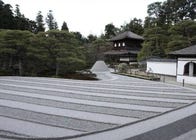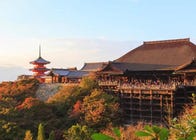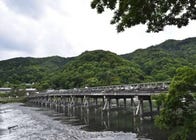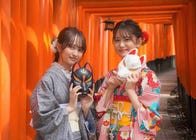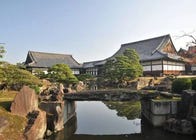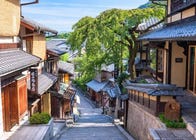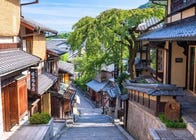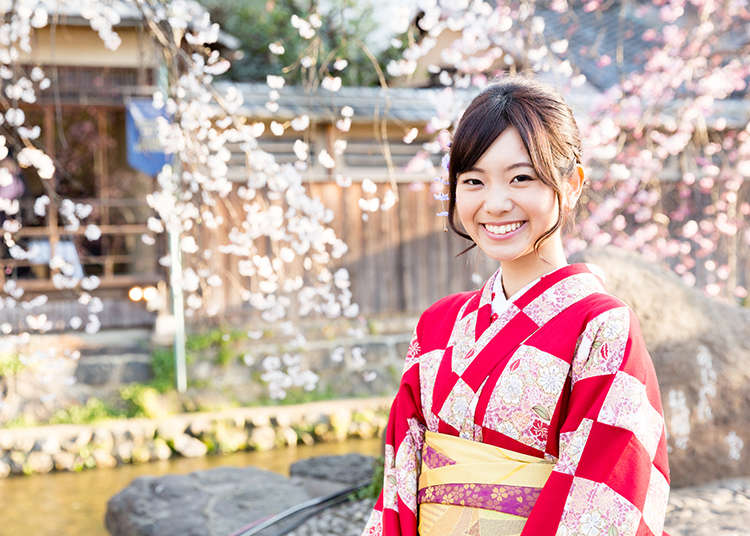
3-Day Kyoto Itinerary: Spring Travel Guide for First-Time Visitors
- Written by: Cassandra Ling
If this is your first time in Kyoto in the spring, then you might be overwhelmed by the number of things to do and see in the city. There are so many great places to see the cherry blossoms, and experience Kyoto culture, that you might have a hard time knowing where to start.
For those of you that like a set plan for your travels, the author, who is a Kyoto resident, has compiled a perfect three-day itinerary that hits all the major sites you won’t want to miss. The plan has about 6 hours of sightseeing time per day, including meals, which gives you plenty to do, and enough time to relax at the end of the day. If you like exploring at a faster pace, check out the additional suggestions at the end of the article.
Read on for a Kyoto trip full of dreamy sites, tasty food spots, and of course amazing temples and shrines.
Day One: Enjoy the highlights of Kyoto
1. Ginkakuji
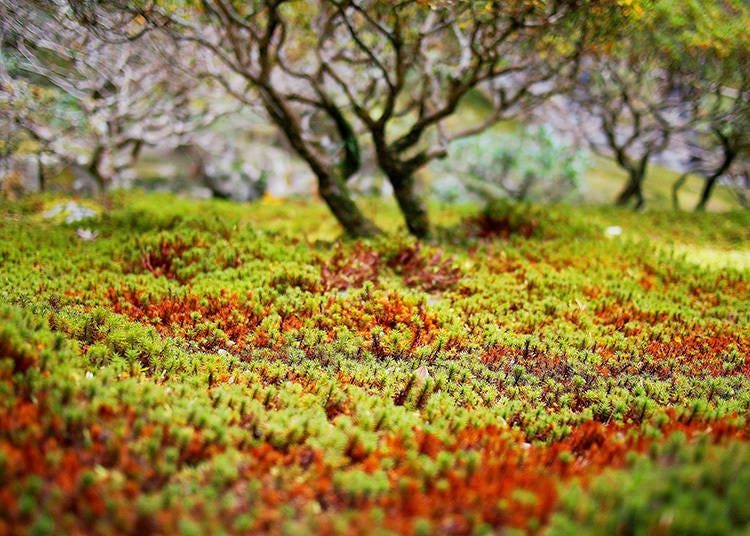
Day one starts at one of the more overlooked temples in Kyoto, Ginkakuji, or “the silver pavilion.” Unlike its counterpart Kinkakuji, which is leafed in gold, Ginkakuji has no such silver decor, but don’t let that stop you from visiting this gorgeous place.
The rich history and stunning grounds are filled with tons of various gardens with winding paths for you to get lost in, and see some amazing views of Kyoto. In spring, Ginkakuji has plenty of cherry blossoms, as well as paths lined with plants and trees to immerse yourself in the new growth of nature.
- Admission: 500 yen
- Access: Take the number 17 or number 5 bus from Kyoto Station and get off at “Ginkakuji-mae.”
- Recommended sightseeing time: It takes about 2 hours to explore the temple and grounds, a bit longer if you are willing to climb up the forest paths in the rear, or if you want to sit and enjoy some sights along the way.
-

-
Address
2, Ginkakujicho, Sakyo-ku, Kyoto-shi, Kyoto, 606-8402
View Map -
Nearest Station
Mototanaka Station (Eizan Dentetsu Eizan Line)
28 minutes on foot
- Phone Number 075-771-5725
-
Address
2, Ginkakujicho, Sakyo-ku, Kyoto-shi, Kyoto, 606-8402
2. Philosopher’s Path
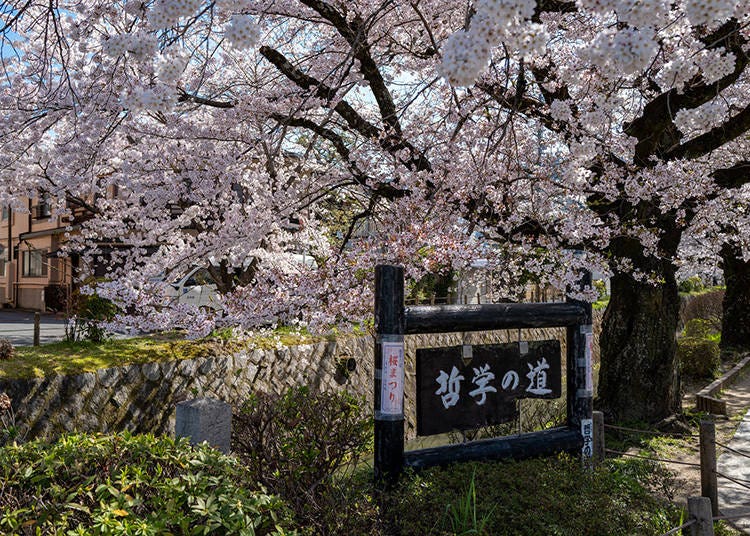
After exploring Ginkakuji, take a quick 5-minute walk to the Philosopher’s path, which runs about 2 kilometers along a canal, leading to Nanzenji Temple.
The Philosopher's Path is named after one of Japan’s most famous philosophers, Nishida Kitaro. While he was a student at Kyoto University, he is said to have walked this path every day.
The path is famous in the spring because the entire waterway is lined with cherry blossom trees.
Tourists flock from far and wide to see the delicate blossoms bloom pink and white along the path, and shop at small traditional shops along the main road.
From the beginning of the path, walk along the canal until you reach the aqueduct near Nanzenji Temple, then continue over toward Keage Incline.
- Admission: Free
- Access: From the entrance of Ginkakuji, walk north 5 minutes on Shirakawa Street and enter the path on the west side of the intersection of Shirakawa and Imadegawa.
- Recommended sightseeing time: The path isn’t long, but there is a lot to see, if you walk slowly and take in all the sights, it can be up to an hour. If you want to do some shopping at the stores at the beginning of the path, leave a little extra time.
3. Lunch at Minokichi Honten Takeshigerou
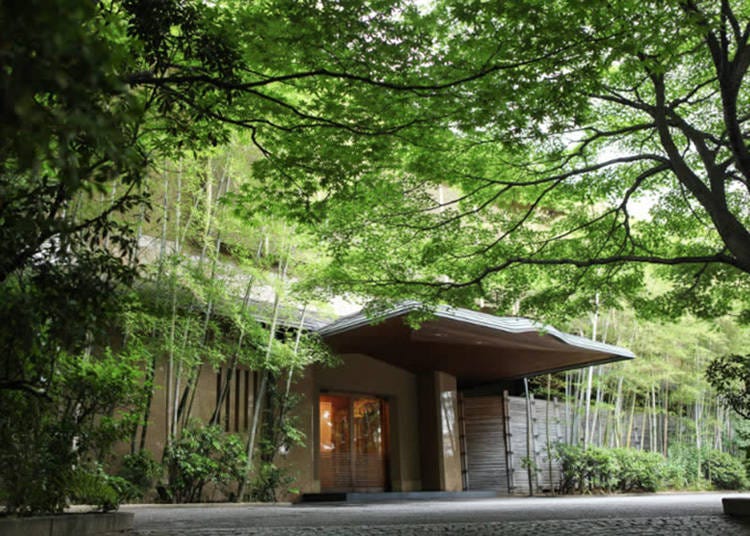
Once you have walked up an appetite, it’s time to have a traditional Japanese-style lunch at Minokichi Honten Takeshigerou.
The restaurant is about a 15-minute walk from the end of the Philosopher’s path and serves Japanese Kaiseki cuisine.
Kaiseki is a multi-course traditional meal, focusing on seasonal vegetables and fresh fish, as well as immaculate presentation and simple flavors.
This is a great place to start if you haven’t had the opportunity to experience Japanese cuisine in the past.
- Access: After walking to the end of the Philosopher’s Path, walk west toward Shirakawa Street and head south, take a right at the stop light, and walk another few minutes to the restaurant. It takes about 15 minutes total to get to the restaurant.
- Tip: Expect lunch to take around an hour. For dinner, guests typically spend around 3 hours here.
-
Minokichi Honten Takeshigerou美濃吉本店 竹茂楼
- Address 65 Awadaguchi Toriicho, Sakyo Ward, Kyoto, 606-8436
4. Keage Incline
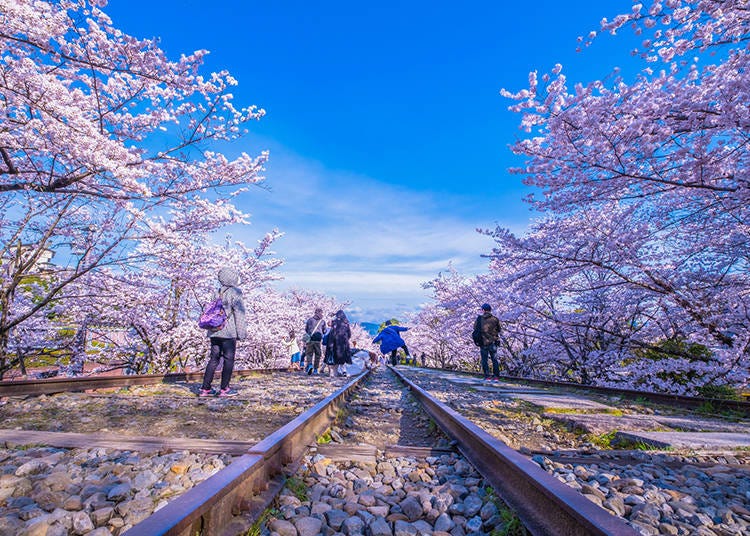
Keage Incline is an abandoned railway that once connected the Kamogawa River to the Biwa Canal. Decommissioned in 1948, this 500-meter track is lined with cherry blossom trees, making it one of the most popular sites to see the blooms in Kyoto. The path is now used to connect hikers to the Kyoto Circuit trail, but in the spring, couples and families flock to the incline to see the old railway tracks get covered in pink and white petals, making a carpet of cherry blossoms.
- Admission: Free
- Access: From the restaurant, walk back east for 5 minutes until you get back to the Shirakawa Street intersection. The Incline is straight south from there.
- Recommended sightseeing time: It doesn’t take long to walk the entire incline, so it can take anywhere from 30 min to an hour to explore the area.
-

-
Address
Nanzenjifukuchicho, Sakyo-ku, Kyoto-shi, Kyoto, 606-8435
View Map -
Nearest Station
Keage Station (Tozai Line)
9 minutes on foot
-
Address
Nanzenjifukuchicho, Sakyo-ku, Kyoto-shi, Kyoto, 606-8435
5. Heian Jingu Shrine
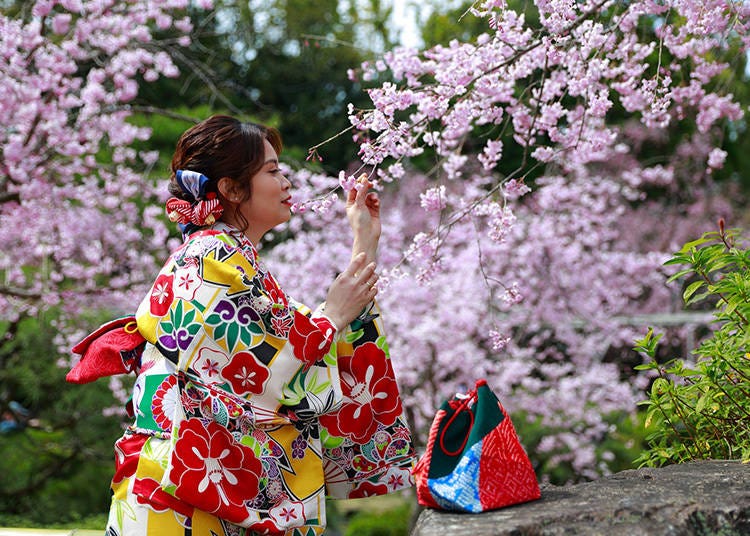
Heian Jingu Shrine is at the heart of a sprawling midtown park called Okazaki Koen. The entrance to the shrine has an iconic huge torii gate that looms over the street, so you can’t miss it. The shrine itself is decorated in classic red-orange colors and the wide-open entrance is usually filled with people praying or admiring the ancient architecture. The park is best known for its huge and winding garden, over 30,000 square meters of small paths, ponds, and plant life that come to life in the early spring. To enter the garden, take a left before the main shrine and pay a small fee of 600 yen. The garden exemplifies Japan’s connection to nature and sports four separate parts, all blending for a peaceful and beautiful walk behind the shrine.
- Admission: 600 yen
- Access: From Keage Incline, head west to Jingu-michi Street, then walk north for about 5 min through Okazaki Park. Follow the giant red torii gate until you get to the entrance of Heian Jingu.
- Recommended sightseeing time: It takes about 40 min to walk just the garden at a leisurely pace, so give yourself at least an hour or more to explore the shrine and garden together.
-

-
Address
97, Okazakinishitennoucho, Sakyo-ku, Kyoto-shi, Kyoto, 606-8341
View Map -
Nearest Station
Higashiyama Station (Tozai Line)
10 minutes on foot
- Phone Number 075-761-0221
-
Address
97, Okazakinishitennoucho, Sakyo-ku, Kyoto-shi, Kyoto, 606-8341
6. Dinner at Nanzenji Junsei
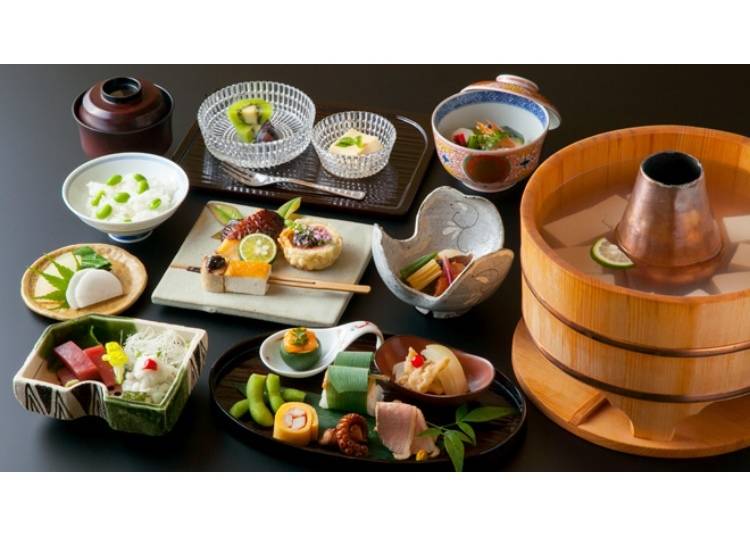
All that walking is sure to make you hungry for a hearty dinner. Just a 5 min walk away from Keage Incline, Nanzenji Junsei is a perfect restaurant to try out one of Japan’s specialties; tofu. This restaurant has great courses with tons of different tofu dishes that will let you explore one of Japan’s most famous dishes. Each course has tofu paired with seasonal vegetables cooked in different ways so you can explore springtime flavors in Kyoto.
7. Explore around Pontocho
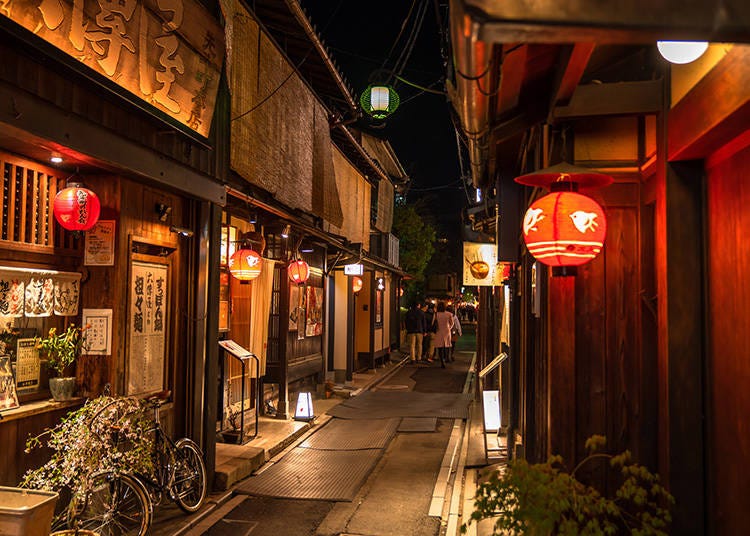
If you have some energy left after dinner, take a 30 min walk or a 20 min train ride to Pontocho Alley for some nightlife. Pontocho is a famous narrow street in downtown Kyoto lined with bars and shops. This traditional alleyway is covered with lanterns and signs that make it a great photo spot, as well as a place to explore a few bars for a late-night drink and to meet some of the locals.
- Access: From the restaurant, you can either walk west for about 30 minutes until you get to Kamogawa River, then after the river, walk south to Pontocho Alley, or take public transit. Either the Tozai train line from Keage Station and get off at Sanjo Keihan, or the number 5 or 32 buses and get off at Sanjo Keihan or Kawaramachi Sanjo.
- Recommended sightseeing time: The alleyway isn't very long, so it should only take you about 30 min to walk the length and explore the bars and restaurants. But take as long as you like, getting a drink and meeting the locals.
-

-
Address
Pontocho, Kiyamachi, Nakagyo-ku, Kyoto-shi, Kyoto, 604-0000
View Map -
Nearest Station
Kyoto-kawaramachi Station (Hankyu-kyoto Main Line)
3 minutes on foot
-
Address
Pontocho, Kiyamachi, Nakagyo-ku, Kyoto-shi, Kyoto, 604-0000
Day Two: Downtown Kyoto
1. Kiyomizu street and temple
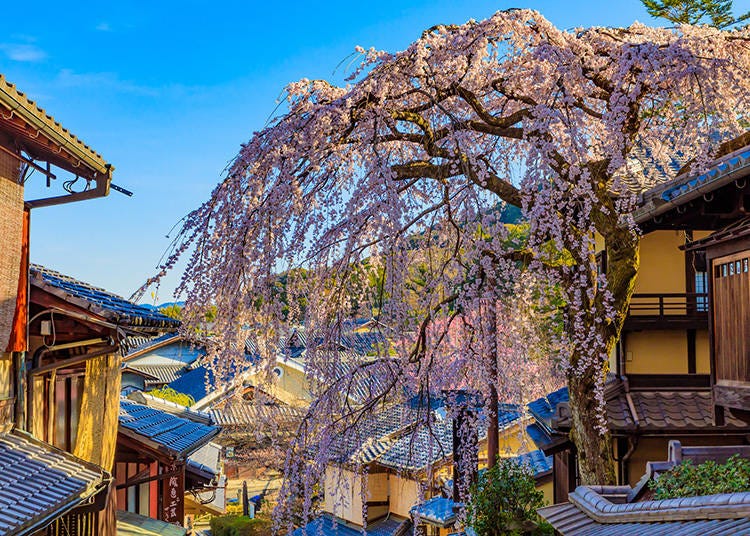
Day two of our Kyoto springtime tour starts with taking the bus to Kiyomizu-michi bus stop, and then walk down Kiyomizu street, a crowded shopping street with tons of energy.
Here you can take a leisurely walk uphill to Kiyomizu Temple, while exploring some traditional food like matcha-flavored sweets or roasted chestnuts, and shopping for souvenirs in different stores.
Once you get to the temple, take some time to walk around and enjoy the ancient wooden structure, pray at one of the various sub-temples, and wash your hands in the pure water that flows from the Otowa waterfall to seek health, a long life, or success.
From the top, you can get amazing photos of cherry blossoms dotting the mountainside, and even stop to have a quick tea and snack.
- Admission: 500 yen (temple only, the shopping street is free to enter)
- Access: Take the 206, 202, 207, or 86 numbered bus from Kyoto Station to Kiyomizu-michi bus stop (230 yen; 25-30 minutes).
- Recommended sightseeing time: This route will take about 2-3 hours, depending on how much shopping you want to do, and how crowded the streets are.
-

-
Address
1-294 Kiyomizu, Higashiyama-ku, Kyoto City, Kyoto Prefecture, 605-0862
View Map -
Nearest Station
Gionshijo Station (Keihan Line)
25 minutes on foot
- Phone Number 075-551-1234
-
Address
1-294 Kiyomizu, Higashiyama-ku, Kyoto City, Kyoto Prefecture, 605-0862
2. Maruyama Park and Yasaka Shrine
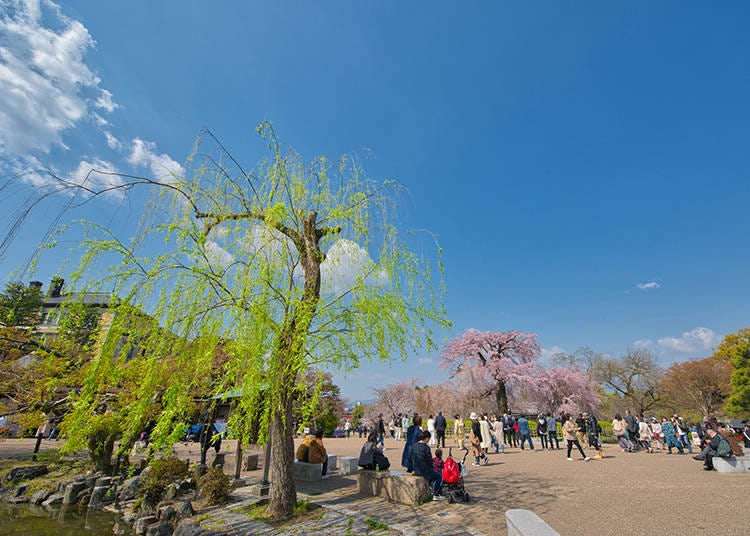
Head west toward Kiyomizu Street and you’ll come to a narrow alleyway called Sannenzaka, where you’ll find several cute traditional shops along the hill.
Continue along this road, curve left, and the pagoda for Hokan-ji Temple will come into view. This is a particularly beautiful scene at this time of year.
At the end of a very busy street called Shijo, this shrine dominates the area with a huge bright red gate that screams Kyoto.
Once inside, you will find tons of paths to explore, and in the spring, they are lined with food stalls selling everything from fried noodles to candied fruit.
The shrine then connects to Maruyama Park, which is one of the most popular spots for cherry blossom viewing in Kyoto.
The park is filled with cherry trees and has a scenic Japanese garden, so it is common to grab a tarp and a drink underneath the falling petals to enjoy the views.
- Admission: Free
- Access: From Kiyomizu temple, walk back down Kiyomizu-michi or Gojo-zaka Street to get back to Higashiyama Street then head north for about 10 min to reach Yasaka Shrine.
- Recommended sightseeing time: Stay at least one hour to walk around the shrine and park, but if you want to sit down and have a drink or snack, make more time for your visit to Yasaka Shrine.
3. Lunch at Sangencha
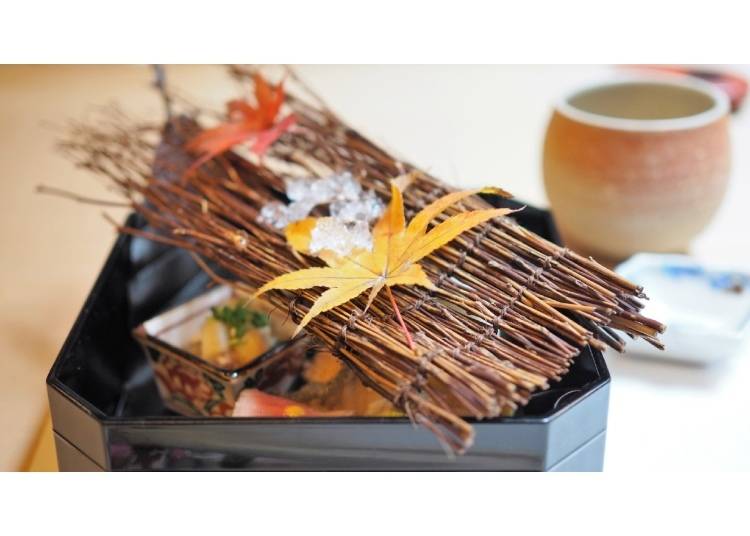
For lunch, take a quick 5-minute walk down the back streets of Gion to try Sangencha. This Kaiseki restaurant on a quiet back street serves traditional Japanese cuisine in multiple tiny courses. It specializes in local delicacies and gourmet food, from vegetables to tofu and fresh fish. The service is personalized to each guest and the meals include Japanese sake for you to try.
- Access: Follow the map northwest for about 5 min.
- Recommended time: Expect lunch to take around an hour.
-
Sangencha山玄茶
- Address 347-96 Gionmachi Kitagawa, Higashiyama Ward, Kyoto, 605-0073
4. Gion Corner
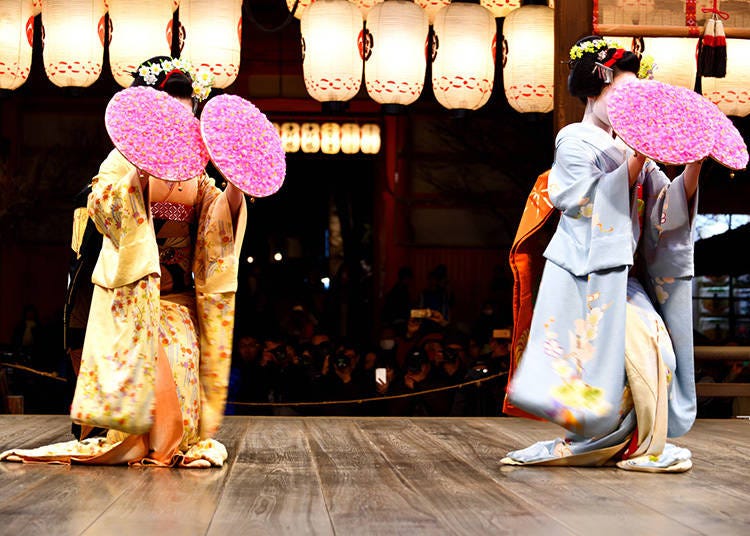
After lunch, make your way to Gion Corner Theater, about a 10 min walk away.
If you haven’t had a chance to experience Japanese cultural shows like dances or theater, Gion Corner is a perfect event that encapsulates seven different Japanese traditions in one.
The show (held at 6 PM) aims to give tourists a taste of a variety of traditional Japanese traditions, including tea ceremony, Kyoto dancing, flower arrangement, music with the koto instrument, traditional court music, kyogen comedic play, and bunraku puppet theater.
- Admission: From 5,500 yen to 6,600 yen, depending on the seat
- Access: Walk south on Hanamikoji Street through the Geisha district for about 10 minutes to reach Gion Corner.
- Recommended sightseeing time: The Gion Corner show lasts about two hours and is the perfect way to experience intimate Kyoto traditions.
-

-
Address
570-2, Gionmachiminamigawa, Higashiyama-ku, Kyoto-shi, Kyoto, 605-0074
View Map -
Nearest Station
Gionshijo Station (Keihan Line)
7 minutes on foot
- Phone Number 075-561-1119
-
Address
570-2, Gionmachiminamigawa, Higashiyama-ku, Kyoto-shi, Kyoto, 605-0074
5. Night in Kiyamachi
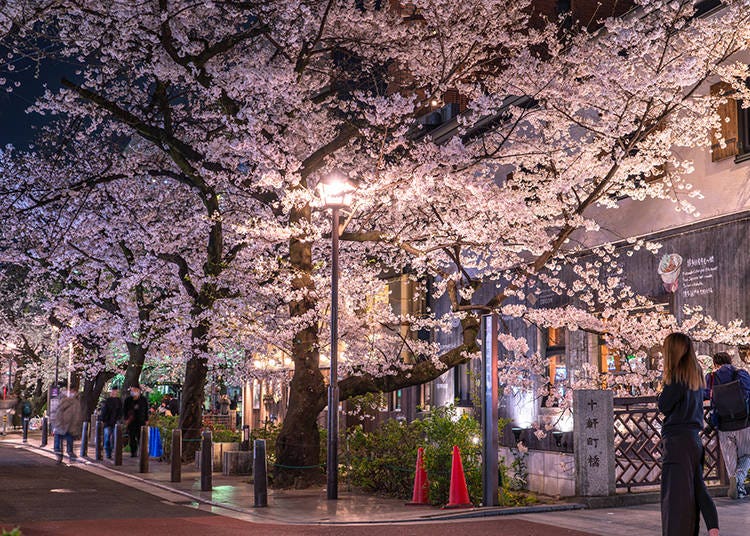
Once you are ready to get up and moving again after the Ginza Corner show, make your way to Kiyamachi Street, about a 20 min walk away from Shijo Kiyamachi on the opposite side of the Kamo River.
Heading north along the street, you will enter the heart of Kyoto nightlife. Along a small canal (the Takase River), both sides of the streets are lined with restaurants, dance clubs, and bars.
This is where many Kyotoites go to hang out after dark and it is a perfect chance to mingle with the locals and have a great meal with drinks. Every block has small side streets filled with small sake bars, or beer gardens resting on the roofs of buildings.
Hawkers call out to you on the street while you walk to charm you into eating at their restaurants or coaxing you into a bar or club. If you are ready to have a lively night now, Kiyamachi is the place to be.
- Admission: Free
- Access: Head north from Gion Corner and then west on Shijo Street until you come to the south end of Kiyamachi, this will take about 10 minutes.
- Recommended sightseeing time: Kiyamachi nightlife can be as long or as short as you have the energy for. Walking to the north end of the downtown district on Sanjo Street will take about 20 minutes, but if you are up for a night of clubbing or drinking you can stay exploring Kiyamachi until morning.
Day Three: Western Kyoto
1. Togetsukyo Bridge
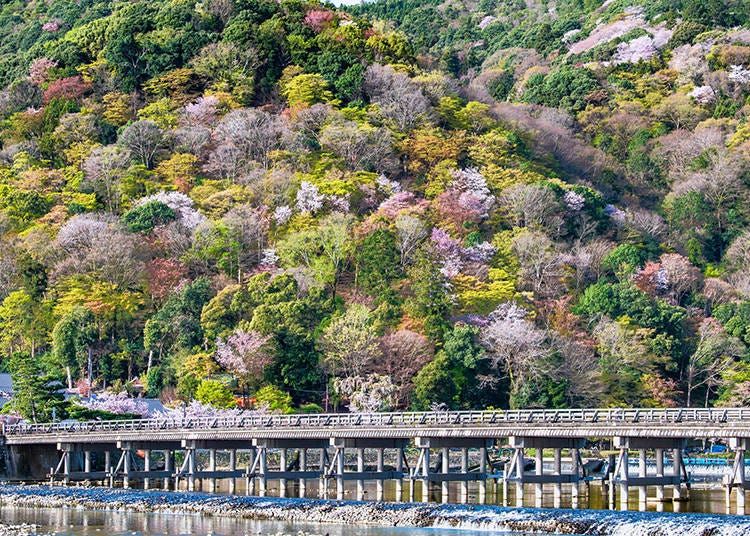
Day three starts off at Togetsukyo Bridge, in the heart of the area of Kyoto known as Arashiyama. The bridge runs over the Katsura River and the views from it are beautiful.
In the springtime, cherry trees with their pink and white blossoms dot the mountains and small covered row boats float across the river. The scene is one for perfecting your photography skills.
It only takes a few minutes to cross the bridge, but there are small food shops along the river to explore if you want to take some leisurely walking time.
- Admission: Free
- Access: From Kyoto Station, take the Sanin Line for about 30 minutes and get off at Saga-Arashiyama Station (240 yen).
- Recommended sightseeing time: Walking along the bridge just takes 5 minutes, but give yourself some time to stop and take photos along the way.
- Tip: If you have a group of people you can rent a charter boat for one hour that takes you around the Katsura River. Renting the boat costs 14,000 yen for 5 people and comes with a guide that uses a pole to take you across the water. If you feel like getting some exercise yourself, there are rental oar boats for 1,800 for up to three people that you can take out on the water for an hour.
- Tip: There are several kimono rental shops near Randen Arashiyama Station. Renting a kimono before heading to Tenryu-ji Temple and the bamboo forest will make for some great photos! But you may wish to return the kimono before continuing your adventure, as they can slow your pace.
-

-
Address
Sagatenryuji Suenobaba Town, Ukyo Ward, Kyoto City, Kyoto Prefecture, 616-8385
View Map -
Nearest Station
Arashiyama Station (Keifuku Dentetsu-arashiyama Line)
3 minutes on foot
- Phone Number 075-411-9990
-
Address
Sagatenryuji Suenobaba Town, Ukyo Ward, Kyoto City, Kyoto Prefecture, 616-8385
2. Tenryu-ji Temple
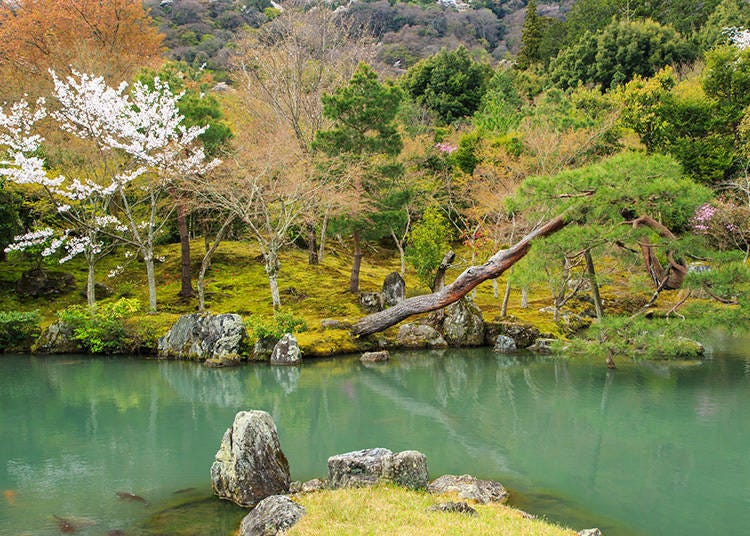
Tenryu-ji is a gorgeous temple with a huge pond in the middle of Arashiyama, set a little bit back from the Randen Arashiyama Station.
It is a great way to step away from the crowds to enjoy a bit of nature.
The temple grounds are vast, covering a huge area with many small paths to a large pond filled with colorful koi fish.
In the spring, cherry trees are found around the pond and reflect into the water.
The temple itself holds exhibitions for different types of traditional Japanese art, so you can check out the painted sliding doors, as well as view the inside of the Japanese temple complex.
- Admission: 500 yen
- Access: Cross Togetsukyo Bridge and walk 5 minutes to the entrance of Tenryu-ji to the north.
- Recommended sightseeing time: It can take anywhere from 1-2 hours to explore the temple and its grounds.
-

-
Address
68, Sagatenryujisusukinobabacho, Ukyo-ku, Kyoto-shi, Kyoto, 616-8385
View Map -
Nearest Station
Arashiyama Station (Keifuku Dentetsu-arashiyama Line)
- Phone Number 075-881-1235
-
Address
68, Sagatenryujisusukinobabacho, Ukyo-ku, Kyoto-shi, Kyoto, 616-8385
3. Arashiyama Bamboo Forest
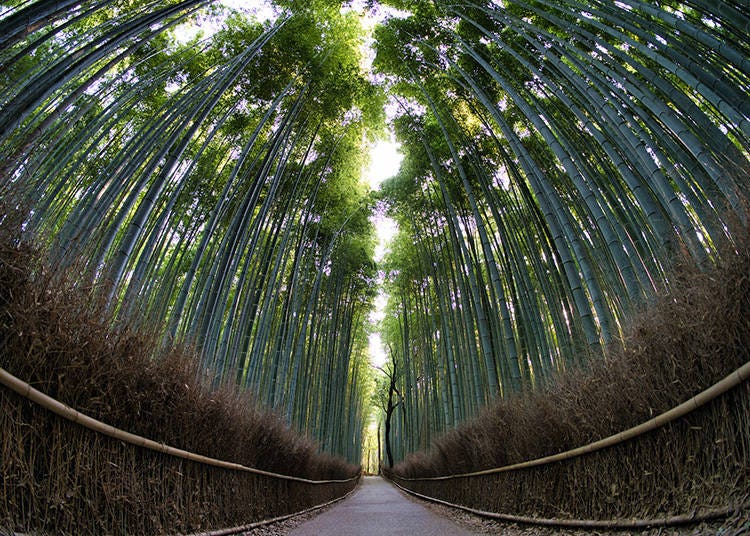
Exit Tenryu-ji at the north gate to walk into the famous Arashiyama bamboo forest. When you think of Kyoto, the bamboo grove in Arashiyama is one of the most recognizable sites. The walk is 400 meters, and each side is lined with bamboo trees that sway gently in the wind. It is a perfect place to take photos and see the care that was put into growing and maintaining the grove.
- Admission: Free
- Access: The bamboo grove is directly at the north exit of Tenryu-ji Temple.
- Recommended sightseeing time: It will only take about 15-20 min to walk through the bamboo grove, but make sure to stop and get some classic photos at the exit.
-

-
Address
Saga Ogurayama Tabuchiyama Town, Ukyo Ward, Kyoto City, Kyoto Prefecture, 616-8394
View Map -
Nearest Station
Torokko Arashiyama Station (Sagano Scenic Railway)
1 minute on foot
- Phone Number 075-213-1717
-
Address
Saga Ogurayama Tabuchiyama Town, Ukyo Ward, Kyoto City, Kyoto Prefecture, 616-8394
4. Hop aboard the Sagano Romantic Train
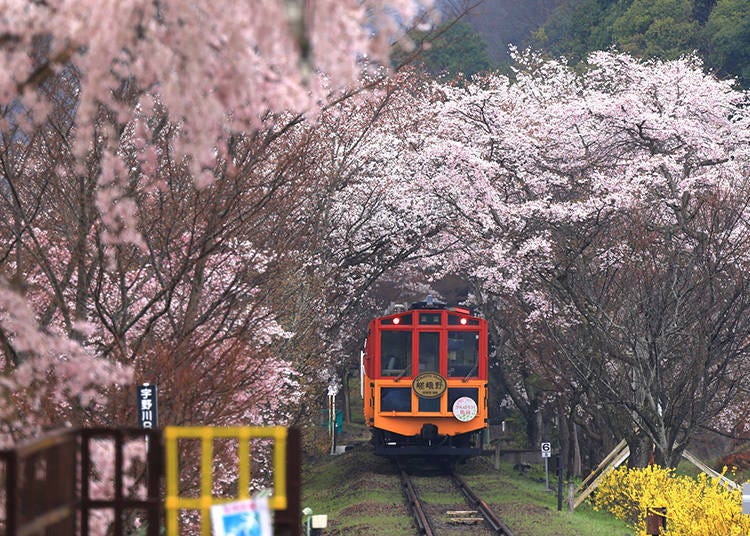
Walk back 15 min through the streets of Arashiyama to get to Saga Torokko Station and get in line to ride the Sagano Romantic Train. This train line goes from Arashiyama to Kameoka, taking about 25 min. The train has an open concept, so seeing the mountain and valley views is easy from any seat. In the spring and fall, the train is most popular, showing off either cherry blossoms or fall leaves that run through the gorge of the Hozugawa River.
- Admission: 880 yen
- Access: Walk east for about 15 min to get to Saga Torokko Station.
- Recommended sightseeing time: The train takes 25 minutes to get to Kameoka Station.
-

-
Address
Kurumamichicho, Saga Tenryu-ji, Ukyo-ku, Kyoto-shi, Kyoto, 616-0000
View Map -
Nearest Station
Torokko Saga Station (Sagano Scenic Railway)
2 minutes on foot
- Phone Number 075-861-7444
-
Address
Kurumamichicho, Saga Tenryu-ji, Ukyo-ku, Kyoto-shi, Kyoto, 616-0000
5. Lunch at Matsusho
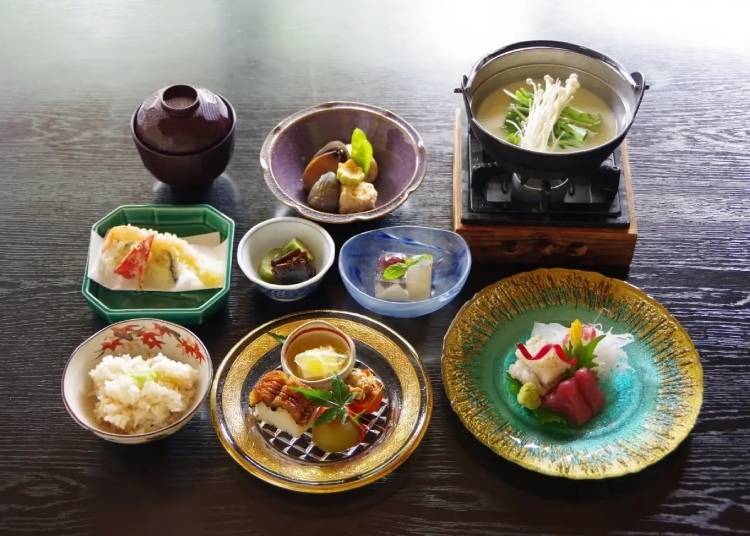
Once you get to Kameoka, take a 15 min walk to check out lunch at Matsusho, a Kyoto specialty restaurant serving course dishes with fresh vegetables, meat, and green tea. The traditional restaurant has amazing views of the garden, along with a huge cherry tree, so you can enjoy spring blossoms while filling up on local dishes.
- Access: From Torokko Kameoka Station, walk south along the main road for about 15 minutes to get to Matsusho.
-
Kyo Ryori Matsusho京料理 松正
- Address Kamikitaura-91-1 Shinochoshino, Kameoka, Kyoto 621-0826
6. Nijo Castle Light up
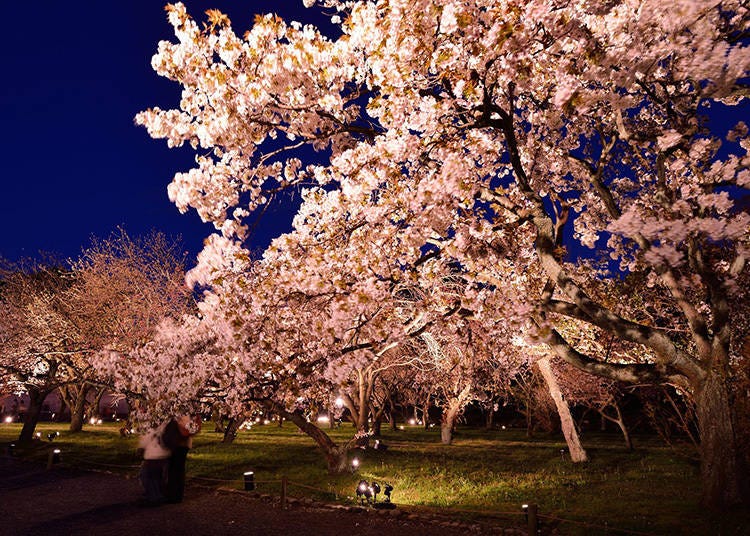
During the day, Nijo Castle has an incredible indoor track where you can explore a ton of Kyoto history, and boasts a massive garden with dozens of cherry trees.
But in the evening, things get even better, as the trees are lit up for a magical night viewing of the cherry blossoms.
The event goes on from March 8th to April 7th and you can enter from 6 p.m. to 9 p.m. (closes at 10 p.m.).
The castle is also home to a digital art event that displays projection mapping illumination on the castle walls.
Walking through the gardens of lit-up petals and illuminated artwork is a once-in-a-lifetime experience.
- Admission: 1,400 yen
- Recommended sightseeing time: Nijo grounds are quite vast, so give yourself an hour or two to walk around and see all the sights.
-

-
Address
541 Nijojocho, Horikawa Nishiiri, Nijo-dori, Nakagyo-ku, Kyoto-shi, Kyoto, 604-8301
View Map -
Nearest Station
Nijojomae Station (Tozai Line)
- Phone Number 075-841-0096
-
Address
541 Nijojocho, Horikawa Nishiiri, Nijo-dori, Nakagyo-ku, Kyoto-shi, Kyoto, 604-8301
Additional Kyoto attractions
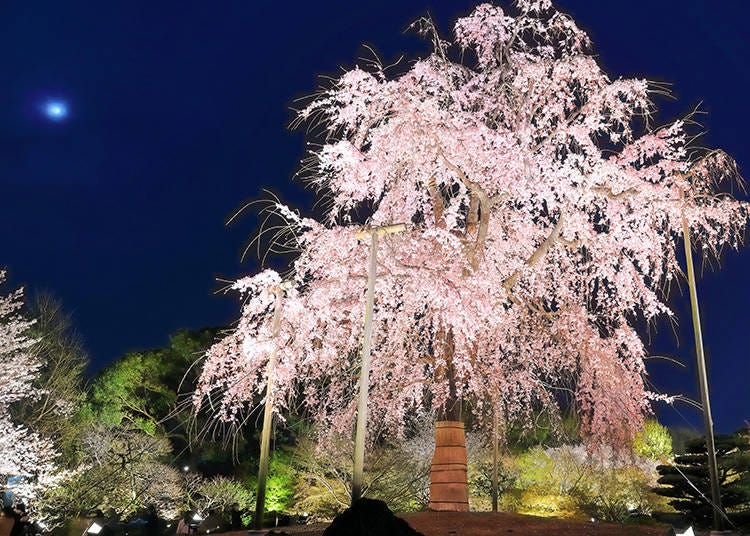
If you have more than three days in Kyoto during the springtime, or if you move quickly while you travel and need some more things to see, check out some other great seasonal sights that could easily make the list of must-sees while you are in Kyoto.
1. Toji Temple
Toji temple is a popular place for seeing cherry blossoms during springtime. The seven-story pagoda towers above a garden filled with cherry trees. Toji temple also has a seasonal nighttime illumination, where the blossoms and pagoda are lit up, so you can enjoy the views after dark as well.
-

-
Address
1, Kujocho, Minami-ku, Kyoto-shi, Kyoto, 601-8473
View Map -
Nearest Station
Toji Station (Kintetsu-kyoto Line)
10 minutes on foot
- Phone Number 075-691-3325
-
Address
1, Kujocho, Minami-ku, Kyoto-shi, Kyoto, 601-8473
2. Hirano Shrine
Hirano Shrine in the north is where the Okasai Festival is held on April 10th, celebrating springtime and the cherry blossoms. If you are in Kyoto around this time, check out the religious procession with Heian period costumes and traditional music, as well as a nighttime illumination that showcases the blossoms.
-

-
Address
1, Hiranomiyamotocho, Kita-ku, Kyoto-shi, Kyoto, 603-8322
View Map -
Nearest Station
Kitanohakubaicho Station (Keifuku Dentetsu-kitano Line)
9 minutes on foot
- Phone Number 075-461-4450
-
Address
1, Hiranomiyamotocho, Kita-ku, Kyoto-shi, Kyoto, 603-8322
3. Fushimi-Momoyama Castle
Fushimi Momoyama is home to an ancient castle, and its grounds are located in a quiet neighborhood in southern Kyoto. The garden features dozens of cherry trees and picturesque views of the rebuilt castle. Since the castle grounds are farther away from popular tourist destinations, this is a great place to enjoy springtime in Kyoto away from the crowds.
-
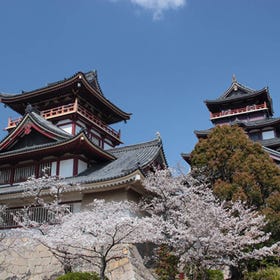 Fushimi-Momoyama Castle伏見桃山城
Fushimi-Momoyama Castle伏見桃山城- Address 45 Momoyamacho Okura, Fushimi Ward, Kyoto, 612-0853
4. Imperial Palace Park/Kyoto Gyoen National Garden
The grounds of Kyoto’s Imperial Palace are massive, with hidden gems and small trails that wind through nature. The surrounding park - Kyoto Gyoen National Garden
- is home to a ton of cherry trees and is a great spot to put down a tarp and have a picnic under the blossoms. Since the grounds are so big, you are sure to find a quiet place to enjoy the springtime weather.
-

-
Address
3, Kyotogyoen, Kamigyo-ku, Kyoto-shi, Kyoto, 602-0881
View Map -
Nearest Station
Imadegawa Station (Karasuma Line)
8 minutes on foot
-
Address
3, Kyotogyoen, Kamigyo-ku, Kyoto-shi, Kyoto, 602-0881
5. Hakusa Sonso Hashimoto Kansetsu Garden & Museum
Hakusa Sonso is an ancient residence and garden of the famous painter Hashimoto Kansetsu. It is one of the only well-preserved residences of painters in Kyoto from the early 1900s and features a large garden, tea house, museum, and a personal Buddhist temple. The garden spans over 10,000 square meters, so it is an easy place to get away from the crowds and get lost in a more peaceful and natural part of the city. In the spring, there are tons of blooming flowers and plants to enjoy throughout the garden. The museum has rotating exhibits that feature Kansestu’s work, as well as other Japanese painters, so you can get a taste of art and history while exploring Kyoto.
-
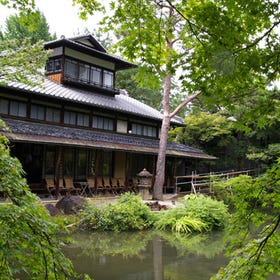 Hakusa Sonso Hashimoto Kansetsu Garden & Museum白沙村荘・橋本関雪記念館
Hakusa Sonso Hashimoto Kansetsu Garden & Museum白沙村荘・橋本関雪記念館- Address 37 Jodoji Ishibashicho, Sakyo Ward, Kyoto, 606-8406
Website: http://www.hakusasonso.jp/
Recommended Kyoto travel passes
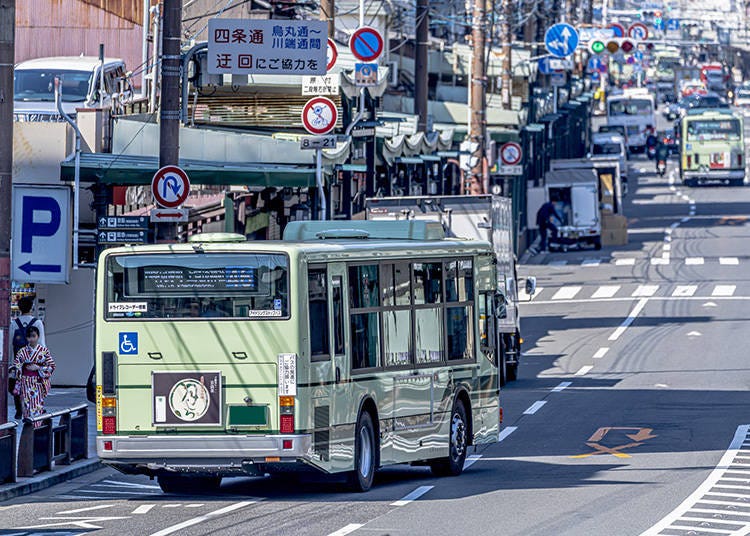
1. Bus One-Day Pass
One of the best ways to get around Kyoto is by bus. The buses go to all the major destinations, they are easy to navigate, and they generally show up on time.
If you will be taking the bus a few times during the day, it is recommended to get a Bus One-Day Pass. The pass can be purchased at Kyoto Station and as well as on the bus itself and costs 700 yen. Scan the card the first time you use it, and then just show the date to the driver every time you get off the bus. The pass is unlimited, so if you are in for a day of sightseeing, it’s a super convenient way to get around.
2. Subway & Bus One-Day Pass
Similar to the Bus One-Day Pass, this pass will let you visit almost all the major sightseeing spots within Kyoto and can be used on subways in addition to the municipal buses, Kyoto Bus (some routes), and select routes on the Keihan bus. The pass costs 1,100 yen for adults.
3. ICOCA Card
If you will be taking the bus less often, or using a combination of trains and buses, you can purchase a prepaid transit card at all the major stations or from our page here.
These contactless IC cards come in various brands - like ICOCA in western Japan and Suica or Pasmo in eastern Japan - but all of them can be charged at the station ticket machines with a predetermined amount of money. Then when you get on and off the train or bus, simply tap your card to pay. (Since these cards are also accepted at many vending machines, convenience stores, and elsewhere, they are a convenient alternative to cash and are a great way to avoid having to dig around in a coin purse for change!)
4. Japan Rail Pass
Finally, while the Japan Rail Pass is excellent for getting around between major cities, it would be applicable only on the Kyoto Station to Umahori Station leg, or from Kyoto Station to Momyama Station (for Fushimi-Momoyama Castle) in this itinerary.
Other recommended tours of Kyoto
If you're looking for a more structured way to explore Kyoto, joining a small tour group can be a great option. These tours provide expert guides, insider knowledge, and a chance to experience the best of Kyoto.
-
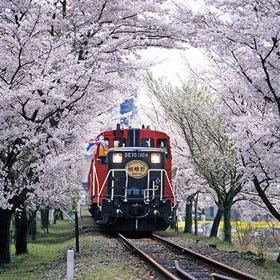 Arashiyama Sagano Scenic Tram and Hozugawa River Rafting Experience Day tour from Osaka
Arashiyama Sagano Scenic Tram and Hozugawa River Rafting Experience Day tour from Osaka
Image: Klook -
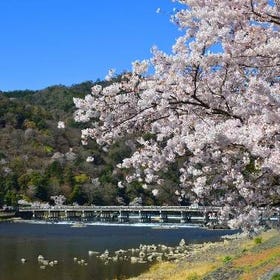 Kyoto and Nara Day Tour from Osaka/Kyoto
Kyoto and Nara Day Tour from Osaka/Kyoto
Image: Klook -
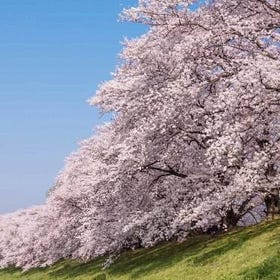 Three Sakura Viewing Spots in Kyoto One Day Tour from Osaka
Three Sakura Viewing Spots in Kyoto One Day Tour from Osaka
Image: Klook -
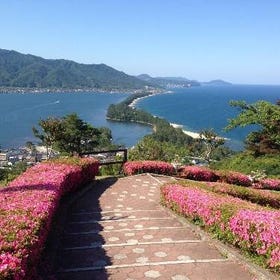 Amanohashidate & Miyama One-Day Tour from Osaka/Kyoto
Amanohashidate & Miyama One-Day Tour from Osaka/Kyoto
Image: Klook -
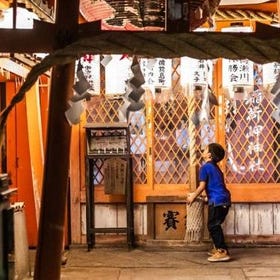 Full Family Day Walking Tour in Kyoto with a Local
Full Family Day Walking Tour in Kyoto with a Local
Image: Klook -
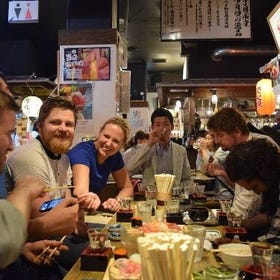 Kyoto Insider Sake Tasting and Brewery Experience
Kyoto Insider Sake Tasting and Brewery Experience
Image: Klook
*Prices and options mentioned are subject to change.
*Unless stated otherwise, all prices include tax.
Popular Tours & Activitiess
Recommended places for you
-
Goods

Yoshida Gennojo-Roho Kyoto Buddhist Altars
Gift Shops
Nijo Castle, Kyoto Imperial Palace
-

Kambei Sannomiyahonten
Yakiniku
Kobe, Sannomiya, Kitano
-

ISHIDAYA Hanare
Yakiniku
Kobe, Sannomiya, Kitano
-

Jukuseiniku-to Namamottsuarera Nikubaru Italian Nikutaria Sannomiya
Izakaya
Kobe, Sannomiya, Kitano
-

Kanzenkoshitsuyakinikutabehodai Gyugyu Paradise Sannomiya
Yakiniku
Kobe, Sannomiya, Kitano
-

Dotonbori
Other Sightseeing
Namba, Dotonbori, Shinsaibashi
-

Everything You Need to Know About teamLab Biovortex Kyoto (2025 Insider Guide)
by: Wemmy Chau
-
Ad

Experiencing Manga as Culture, Not Just Reading It: Expo 2025 with Rumiko Takahashi
-

Curious About Sake? I Visited a Sake Brewery in Japan and Here's What I Learned
-
Ad

Visiting the Osaka–Kansai Expo? Enjoy These 5 Great Itineraries from Osaka-umeda for Nature and City Lovers
-
Ad

Discover Timeless Beauty: Kimono-en, a Web Magazine Exploring the Spirit of Kimono
-

Dorsett by Agora Osaka Sakai: Stay in a World Heritage Port Town Surrounded by History and the Sea (Newly Opened in 2025)
by: Yotsuka Hizuki
Inspiration for Accommodations
-

Spacious Family Hotel in Namba: 20 Comfortable Stays for Family Fun
-

Charming Hotels to Enjoy the Spectacular Views of Arashiyama's Autumn Leaves from Your Room
-

Experience Stunning Views of Osaka Castle from Private Spaces: Top Hotels Near Osaka Castle
-

Recommended by Visitors! Arashiyama's Best-Rated Hotels
-

Family-Friendly Universal Studios Japan Hotel with Excellent Access
-

Enjoy a Comfortable Stay in Osaka! 10 Hotels with Convenient Airport Shuttle Services
-

Top 10 Recommended Hotels Near Namba Station with Great Access
-

Enjoy Night Views from Your Room! Recommended Hotels in Namba Area
-

Hoshinoya Kyoto: This Incredible Japanese Hotel Welcomes You By Boat on a Sakura-Filled River
-

Locals Recommend: 10 Favorite Places for Cherry Blossoms in Osaka
-

2025 Cherry Blossoms in Kobe: 10 Best Viewing Spots & Festival Dates
by: Guest Contributor
-

Visiting Kyoto During Cherry Blossom Season in 2025: Complete Guide & Viewing Tips
by: Cassandra Ling
-

Visiting Osaka in Spring (March/April/May): Weather, Clothing Tips & Must-See Attractions
by: WESTPLAN
-

Inside Kyoto's Spectacular Sanjusangen-do Temple with 1,000 Gold Statues
- #best gourmet Osaka
- #things to do Osaka
- #what to do in kyoto
- #what to bring to japan
- #best gourmet Kyoto
- #new years in Osaka
- #what to buy in nanba
- #Visiting Osaka
- #onsen tattoo friendly arima
- #daiso
- #Visiting Kyoto
- #best japanese soft drinks
- #japanese fashion culture
- #japanese convenience store snacks
- #japanese nail trends














